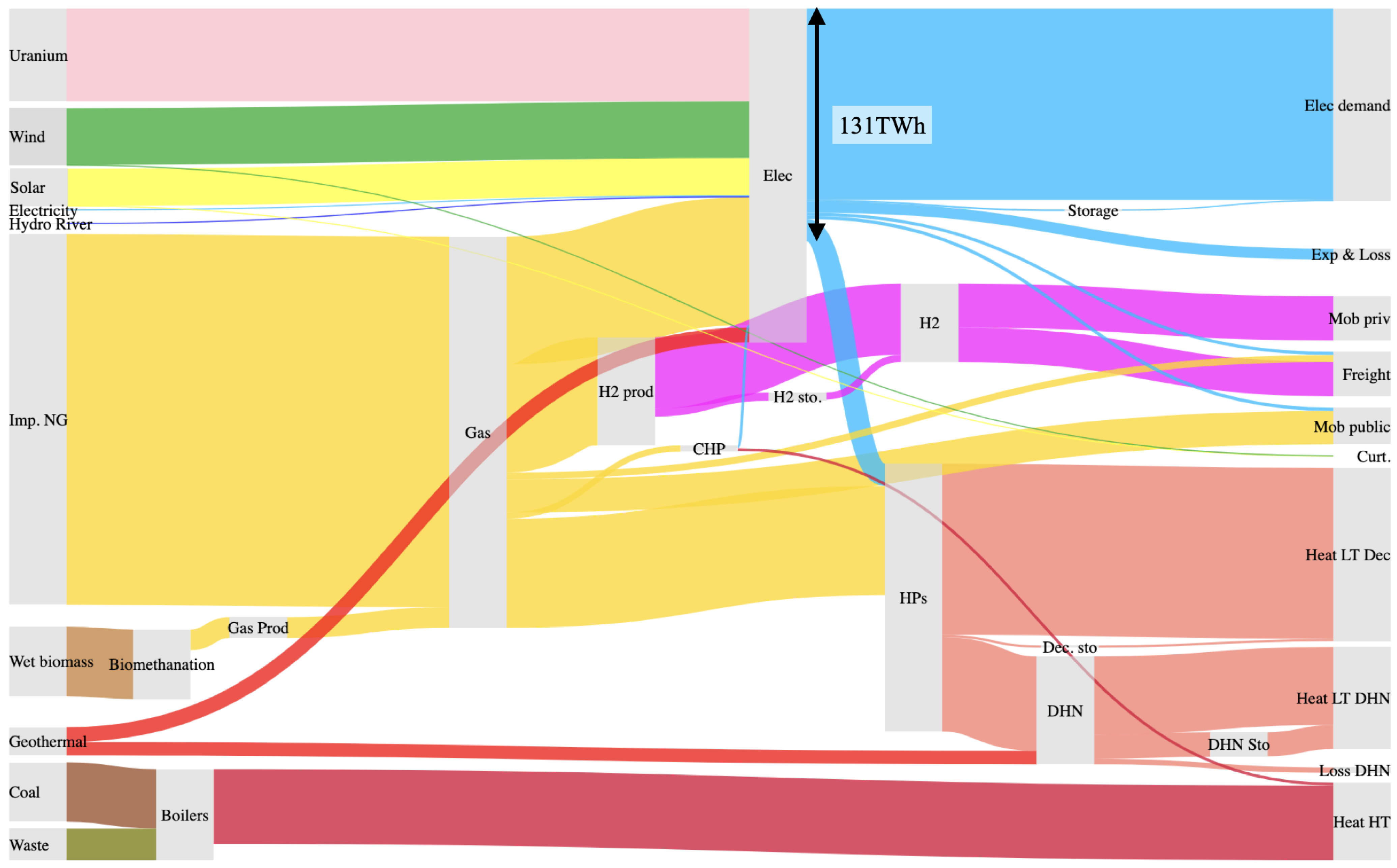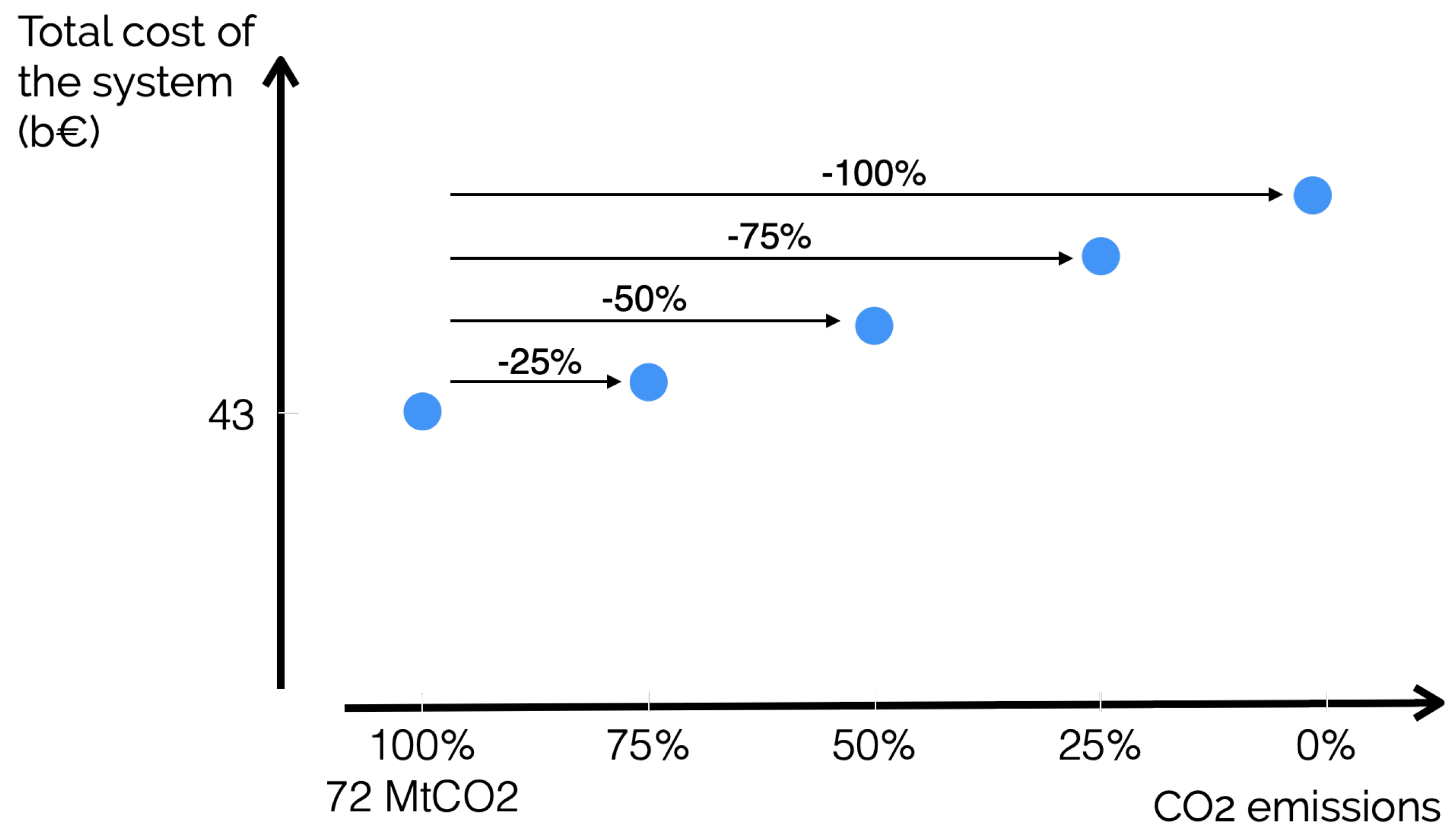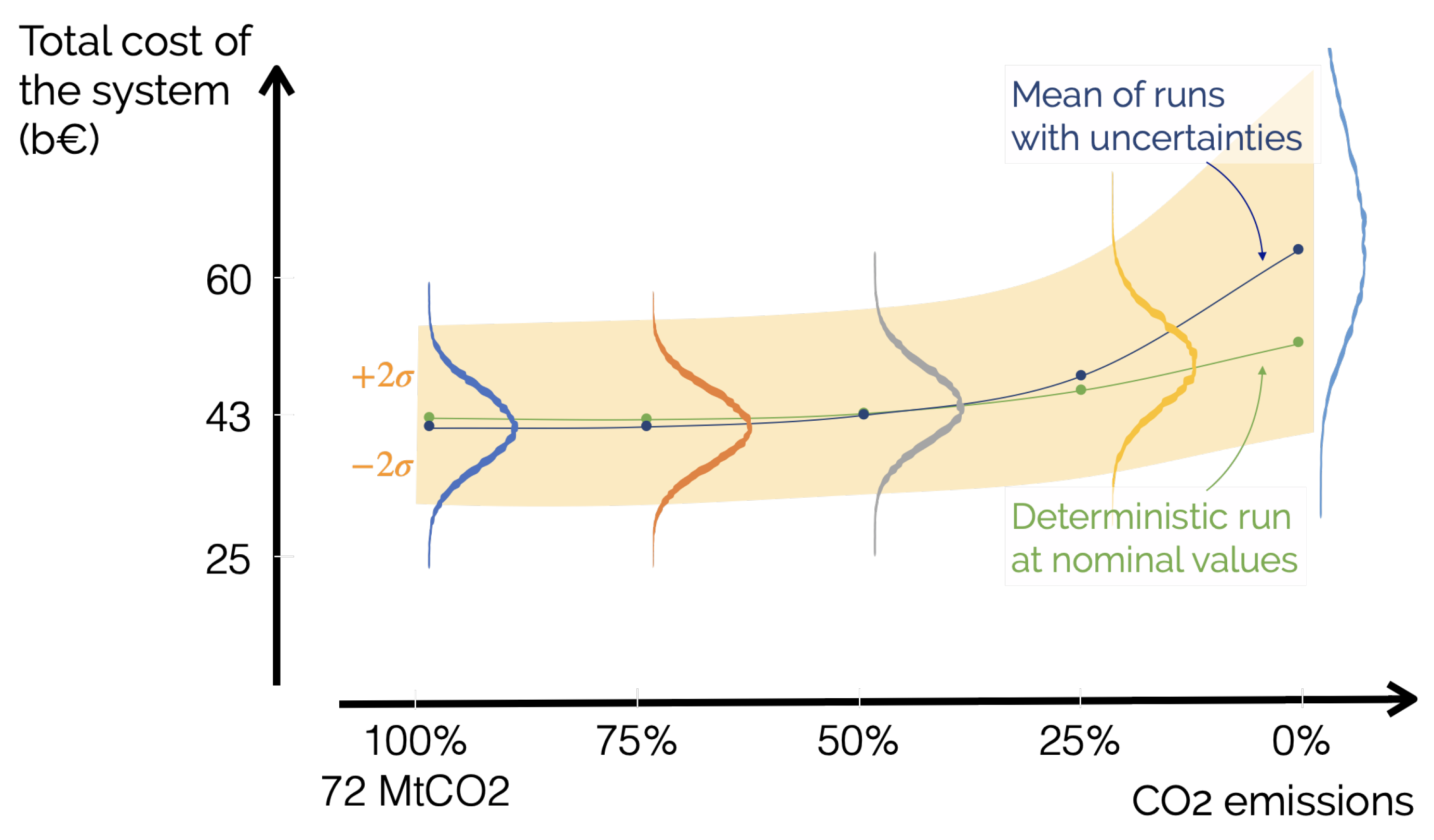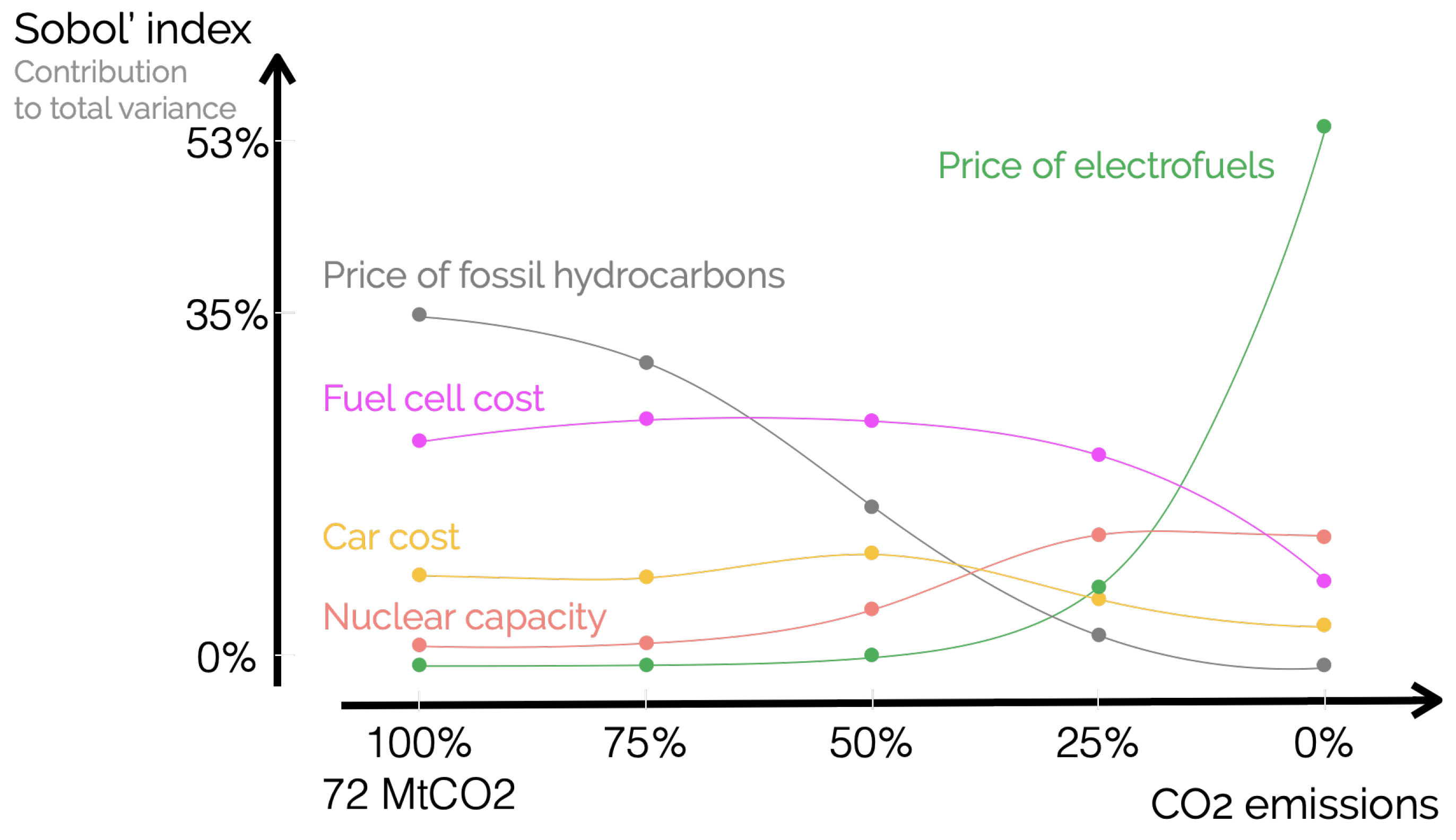5.1. Main Outcomes
First and foremost, uncertainty quantification (UQ) has to be considered as one of the key challenges for bottom-up energy system model [
54]. To avoid underestimating the cost of a carbon neutral whole-energy system, accounting for uncertainties is crucial, especially in a long-term scenario [
55]. In their work, Li et al. [
51] carried out a similar GSA on the Swiss energy system. On one hand, these authors also highlighted an increase in the mean total annual cost of the system while increasing progressively the penetration of renewables. On the other hand, unlike the current work, Li et al. [
51] showed a closer evolution between the results from a deterministic optimisation and the ones resulting from the mean of uncertainty runs. Moreover, in their work, the ratio between the standard deviation and the mean of the total cost (i.e.,
) decreased with the integration of renewables in the system. These two major differences can be explained by the fact that, to obtain a fully renewable energy system, Switzerland can rely on a significant potential of domestic renewables (e.g., around 37 TWh/y of hydro [
46]), and hence decrease its dependency on highly uncertain imported commodities. On the contrary, given its limited renewable potential (compared to its end-use demands), Belgium has to import expensive electrofuels with highly uncertain prices to achieve carbon neutrality in 2050. This drives up the mean and the variance of the total annual cost.
Efforts should not be spread equally into reducing the uncertainties of every parameter. For instance, given this limited potential of renewable energies and a higher level of maturity (i.e., less uncertainty), uncertainties related to solar PV and wind turbines already have negligible impact on the variation of the total cost of the system: the investment costs of PV and wind onshore have a maximum Sobol’ index (i.e., contribution to total variance of the cost) of 1.1% and 0.4%, respectively, while their respective capacity factor impacts only up to 1% the variation of the total cost of the system. On the contrary, a handful of parameters, mostly depicted in
Section 4.2, dominate this variation. These parameters shall capture the majority of the efforts to reduce their uncertainties, especially those that play a major role at higher climate targets, such as the price of electrofuels. Indeed, results first showed a system highly relying on cheap fossil resources, when no limit is put on its emissions. Then, to meet the successive climate targets, the model will sequentially implement the solutions of the
Mix scenario presented by Limpens et al. [
29], which is a scenario accounting for an increased amount of renewable resources plus nuclear capacity and geothermal energy. At early stages, the system will first improve its energy efficiency, as it reduces the primary energy consumed to meet the same demand. For instance, CHP substitutes CCGT and boilers to produce in parallel electricity and heat. Then, to enhance the electrification of the other sectors (i.e., heat and mobility) while reducing the overall global warming potential (GWP), the system imports electricity and uses local renewable electricity production up to their respective full potential: 32 TWh of electricity import, solar (59 TWh), and wind (34 TWh). Finally, to achieve carbon neutrality and to completely phase out of the fossil resources, relying only on imported electricity (even if assumed to be carbon neutral) would mean, in practice, increasing considerably the grid reinforcement and grid interconnections with neighbouring countries, as recommended by some studies [
56,
57]. Such a solution is, for instance, promoted by Brown et al. [
10] as a way to reduce the whole European energy system costs substantially. In the case of this study, without allowing import of renewable fuels and, besides endogenous renewables (i.e., solar, wind), relying only on electricity imports, even if assumed to be carbon neutral, would mean importing around 100 TWh from abroad in the “0%-scenario”. This would be 74% more than what the 6500 MW maximum simultaneous import capacity, assumed by ELIA [
56], could provide if this import capacity was supplying Belgium at “full load” every hour of the year. At more ambitious climate targets, this is why the model forces the system to massively import such electrofuels, among which, on average, 53 TWh of hydrogen, 40 TWh of electro-methane and 4 TWh of electro-liquid fuels. Similarly, in their analysis of the integration of the electrofuels in parallel with a high penetration of variable renewable energy sources (VRES) in Germany, Millinger et al. [
16] highlighted that the impact of electrofuels increases with the reduction of GHG emissions to defossilise hard-to-electrify sectors. For the case of the whole-energy system of Belgium, due to the limited availability of imported and local renewable electricity, electrifying the private mobility stays limited (i.e., from 35%, on average, in the “100%-scenario down to 26% in the ”0%-scenario“), as detailed in
Section 4.2. This goes against the general emerging trend in electric mobility observed in the literature [
58] and the policy measures to promote it [
59]. Such an analysis emphasises the need to consider a whole-energy system approach rather than an electricity-only system [
21]. Given these observations, on the road to a robust whole-energy system in Belgium, the policy makers, the industries, and academia should spend time and energy to improve the knowledge about these electrofuels (i.e., to reduce their cost and their uncertainty) by investing in projects to produce and use these fuels or developing the exchange networks with neighbouring countries. A similar conclusion has also been drawn by Ridjan [
60] in the case of Denmark where he promotes, among other things, “
to intensify research, development and demonstration within key technologies for electrofuels”.
On a broader perspective, one notices that the maximum capacity of nuclear power plants has a lower impact on the variation of the total cost, up to 13.1%. This highlights that, even when considering a wide range of variation (e.g., between total phase out and current capacity), nuclear power plants will not be the main driver of the cost variation. Nuclear electricity will not compete against renewables, either local or imported. On the contrary, nuclear energy would ease a progressive and deeper integration of renewables while keeping up a baseload production of electricity.
As another hot topic in the research field of the energy transition, one would be interested in the impact of biofuels on the variance of the total cost of the system. Similarly to electrofuels, biofuels can be produced locally (e.g., through gasification, pyrolysis, or biomethanation) or directly imported (e.g., biodiesel and bioethanol) and can substitute their fossil equivalents (e.g., natural gas, diesel, and gasoline). However, in general, in the Belgian energy system, lignocellulosic biomass and wet biomass are more efficiently used directly to produce heat than to be transformed into biofuels. Moreover, imported biofuels are assumed to be slightly more expensive than imported electrofuels (e.g., nominal cost of import is equal to 200 €/MWh for bioethanol compared to 190 €/MWh for electro-liquid fuels). Finally, these imported biofuels, implemented in the model only as liquid biodiesel and bioethanol and substituting diesel and gasoline, present a reduced versatility and efficiency (i.e., usable in a less efficient internal combustion engine in the mobility sector) compared to electrofuels (e.g., electro-methane used in gas CHP to produce electricity and heat or hydrogen to supply more efficiently fuel cell cars or trucks). Due to these aspects, biofuels have a low impact on the system, its total cost, and its variance. Affected by the same uncertainty range [−47.3%; +89.9%], the maximum Sobol’ index of the cost of import of biofuels is 2.8% in the 0%-CO2 case, compared to 53.2% for electrofuels.
Given the expensive price of electrofuels, carbon capture and storage (CCS) could offset fossil fuel emissions and avoid the high cost of these fuels. Although, the potential of carbon dioxide sequestration in Belgium is low (i.e., around 1 GtCO
2 [
61], which represents 10 years of emissions) and is competing with other applications (e.g., gas storage). An ongoing project is to deliver this CO
2 to the Netherlands or even Norway to sequestrated it in depleted fields [
62]. This work focuses on how to reduce GHG of the Belgian energy system without considering compensation via the export of CO
2 to other countries. Therefore, the results show a trade-off between minimizing the cost and emissions. Solution as exporting CO
2 abroad could be investigated to mitigate this cost, but is out of the scope of the study.
5.2. Limitations
Models and methods are tailored for specific applications and are fraught with limitations. In this case, limitations can either be caused by the model or the uncertainty characterisation and quantification. Regarding the limitations about the whole-energy system model, EnergyScope TD, Limpens et al. [
27] already listed some limitations. Among others, the snapshot approach [
44], consisting in optimising the system in a target future year, limits the vision of a trajectory between the energy system of today and the one in 2050. As the objective is to provide decision makers with guidelines towards a renewable energy system, an actual pathway could describe the different steps, in a continuous way, in terms of technologies to implement and resources to exploit. Even though other models, such as EPLANoptTP [
63] and OSeMOSYS [
64], perform it for deterministic optimisation (to limit the impact of the “curse of dimensionality”), they already provide such a formulation. The implementation of the electrofuels in the model also presents some limitations. Rather than being detailed in different individual fuels (e.g., methanol, DME, oxymethylene ether (OME)) [
65,
66], they are grouped in three sets (i.e., hydrogen, electro-methane, and electro-liquid fuels). In the current version of the model, these fuels can substitute directly their fossil equivalents without additional cost that adapting the conversion technology, for instance, could cause. Like other imported commodities (except electricity limited by the grid interconnections), imported electrofuels are set at a given price equal to the production cost (and not resulting from a market equilibrium), regardless of their origin, and have an unlimited availability. The representation of the mobility sector is also limited as there is no distinction between “short-range” and “long-range” needs. This agglomerated demand can then be supplied by any transport mode, regardless of its autonomy range or their actual purpose (e.g., tramways aim at providing short-range transport). To overcome this limitation, an improvement could be to split the mobility demand into short-range and long-range demands and allocate specific transport modes to each of these. Further, in the perspective of the European Green Deal, assuming an uncertainty on the GWP impact of the imported electricity can be debatable. Indeed, in this work, this assumption (i.e.,
∈ [0; 0.1] kt
/GWh) forces the system to remove the import of electricity from its strategy in the “0%-scenario”. Consequently, this gives a bigger share to the electrofuels to produce the electricity, on average, in this scenario, CCGT and CHP running on electro-methane and hydrogen-powered CHP substitute the imported electricity and account for 11%, 9%, and 8% of the electricity production, respectively.
Some limitations also concern the uncertainty characterisation and quantification. Thereon, Moret et al. [
24] states: “
A different characterization of input uncertainties substantially changes the results”. The uncertainty ranges considered in this work are based on an exhaustive and multi-criteria approach proposed by [
24]. However, especially in the booming field of electrofuels, new data and new publications could allow refining these ranges. This work also assumes a uniform distribution between the lower and upper bounds of the uncertain parameters. Collecting more data could also refine the distribution to consider. In the generation of samples of the PCE, the uncertain parameters are assumed independent. For instance, a higher cost of investment and a lower efficiency of an electrolyser can be present in the same sample whereas, in practice, one would expect a proportional relation between investment cost and efficiency. This independence of uncertainties is although required to benefit from the computational efficiency of the PCE. When dependent, the proof for orthogonality of the polynomials no longer holds. Other methods, such as Monte Carlo analysis, does not require this independence but usually need more model evaluations (i.e.,
compared to 1980).












